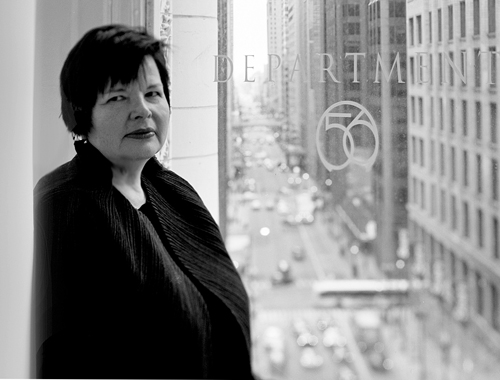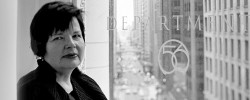
We tend to think of enjoying art as an experience that involves simply looking at things: at a painting that hangs on a museum wall, perhaps, or a statue in a park.
But Mary Jane Jacob, a professor and executive director of the Art Institute of Chicago’s exhibition program, argues that art involves so much more than this.
Jacob, who has been involved with many groundbreaking projects in her long curatorial career, will be delivering a Master of Fine Arts lecture at Portland State Monday, May 14, on art as social practice. She will address how one should approach the experience of art and the interconnectivity between the artist and the viewer, as well as the internal and external forces affecting the artistic experience.
In this Q-and-A with the Vanguard, she speaks of her extensive research, her past projects and how her philosophy has helped to shake up the public art scene.
Vanguard: For your upcoming lecture, what will you focus on?
Mary Jane Jacob: I was invited by Open Engagement, part of [PSU’s] Art and Social Practice program, so I will be speaking about socially engaged practice today and my thoughts on what I think that artists are importantly engaging in at the moment, and what this way of working has to offer for a relationship between art and the audience.
VG: Can you tell me about some of the research, such as your more recent work, the anthology Learning Mind: Experience Into Art?
MJJ: I’ve done a number of books related to this larger field of expanded social practice over the last 20 years, so that is just one of them.
But it began with some books that came out of groups of projects that were really testing grounds for artists in the early and mid ‘90s, to create projects within communities and under long time periods of investment with certain populations.
And so those initial things…dealt with the projects set up within those circumstances, and on the group learning lessons that, at that point, was an experimental way of working and is now more established, but still seems to raise some of those same questions that it did even 20 years ago:
Why is it art? Or why do we even bother to call it art? And even why is it the work of an artist?
At the same time, I think that those questions are not of concern for many practitioners within the arts field. We’ve seen an explosion of this kind of practice—here and in other countries—in terms of its usefulness and its validity for artists themselves as artistic practice and ways of life.
This has led to my own research, looking at some of the origins of that and some of the things that can be learned from some of those great artists who are working in this fashion. Learning Mind: Experience into Art is one such publication and was immediately preceded by Buddha Mind in Contemporary Art. Their points interlock in terms of discourse around a work of art, and what does the artist contribute toward the art experience, and what does the viewer or participant bring to that experience.
VG: It seems that it involves not the art itself but the culture, bringing the citizen and viewer into the equation.
MJJ: That’s one facet of it. Books like Learning Mind and Buddha Mind go into larger and more overarching ways of thinking about art that are not specific to social practice and public art, but that can inform our current day reflection back on that art by looking at some of the essential questions around art itself.
As being not simply or wholly a product that comes from the artist-as-maker in determining both what is the art and what is the artist experience, but always acknowledging the role of the viewer within that and changing the way we look at art, to not restrict to a single genre such as “community-based public art.”
It shares in a larger discourse about art itself and, in some ways, tries to answer those questions about why is social practice art, and maybe in answering those questions show that those questions are not the point at all. When we draw that frame, we might always be in a debate with others about just where that frame exists, but if we unframed reality, we might find where art is in a larger or omnipresent way.
VG: How did these kinds of questions come to you as you started your career, and when did this really become a focus for you?
MJJ: Previous to working in public spaces, I worked for 25 years in museums, and I would say it came out of that experience and what I found to be the highly problematic, compromised and oftentimes nonexistent experience with art in spite of the art that was on view.
VG: I have often heard from artist friends that art seems “trapped” in museums, putting a wall between the viewer and art.
MJJ: Trapped as in constricted silenced. I agree with your friends!
VG: Did you start out as an artist, or did you always want to do curatorial work?
MJJ: I did start as an artist, but I wasn’t in a fabulous place for it. And I quickly rebooted myself with why I was interested in art at all, which came from my experience of it. Yes, sometimes from the making of it, but more so the experience of it. And so I switched to an art history tract and did my master’s with museum orientation, which was the degree at the time.
There weren’t really curatorial programs [then]. I wanted to go to the place art was. I never wanted to teach art history. That was never my goal. And I still don’t do that.
VG: What are some of your favorite or memorable projects that you’ve been involved with?
MJJ: A watershed group of projects for me was called Culture in Action in Chicago. They really aimed about these questions around art and audience and didn’t really have to become concrete works at all, but in all the cases they did. Because, in fact, the artwork was necessary for that communication, so it was kind of confirming about the art.
Tele-vecindaro by Inigo Manglano-Ovalle was a temporary project which was so transformative for the participants as well as the viewer, and led to the creation of an organization that still exists today in Chicago.
Monday, May 14
7:30 p.m.
Shattuck Hall Annex
Free and open to the public

